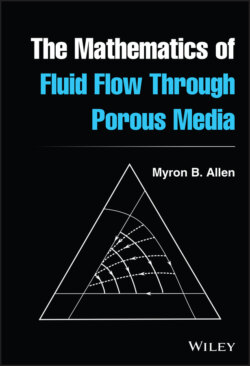Читать книгу The Mathematics of Fluid Flow Through Porous Media - Myron B. Allen III - Страница 10
Preface
ОглавлениеSeldom turns out the way it does in the song.
Robert Hunter
This book provides a semester‐length course in the mathematics of fluid flows in porous media. Over a 20‐year span, I taught such a course every few years to doctoral students in engineering, mathematics, and geophysics. Most of these students' research involved flow and transport in groundwater aquifers, soils, and petroleum reservoirs. The students' mathematical backgrounds ranged from standard undergraduate engineering requirements to more advanced, graduate‐level training.
The book emphasizes analytic aspects of flows in porous media. This focus may seem odd: Most mathematically oriented scholarship in the area is computational in nature, owing both to the heterogeneity of natural porous media and to the inherent nonlinearity of many underground flow models. Nevertheless, while many superb books cover computational methods for flows in porous media, intelligent design of numerical approximations also requires a grasp of certain analytic questions:
Where do the governing equations come from?
What physics do they model, and what physics do they neglect?
What qualitative properties do their solutions exhibit?
Where appropriate, the book discusses numerical implications of these questions.
The exposition should be accessible to anyone who has completed a baccalaureate program in engineering, mathematics, or physics at a US university. The book makes extensive use of multivariable calculus, including the integral theorems of vector field theory, and ordinary differential equations. Several sections exploit concepts from first‐semester linear algebra. No prior study of partial differential equations is necessary, but some exposure to them is helpful.
After a brief introduction in Chapter 1, Chapter 2 introduces the mass and momentum balance laws from which the governing partial differential equations arise. This chapter sets the stage for a pattern that appears throughout the book: We derive governing equations, then analyze representative or generic solutions to infer important attributes of the flows.
Chapters 3 through 5 examine models of single‐fluid flows, followed by models of the transport of chemical species in the subsurface. After a discussion in Chapter 6 of multiphase flows, traditionally the province of oil reservoir engineers but now also important in groundwater contaminant hydrology and carbon dioxide sequestration, Chapter 7 provides an overview multifluid, multispecies flows, also called compositional flows. This level of complexity admits few analytic solutions. Therefore, Chapter 7 focuses on model formulation.
Two features of the book deserve comment.
Over 100 exercises, most of them straightforward, appear throughout the text. Their main purpose is to engage the reader in some of the steps required to develop the theory.
There are four appendices. The first simply lists symbols that have dedicated physical meanings. The remaining appendices cover three common curvilinear coordinate systems, the Buckingham Pi theorem of dimensional analysis, and some aspects of surface integrals. While needed at certain junctures in the text, these topics seem ancillary to the book's main focus.
I owe thanks to dozens of students at the University of Wyoming who endured early versions of the notes for this book. These men and women convinced me of its utility and offered many corrections and suggestions for improvement. Professor Frederico Furtado kindly offered additional corrections, generous encouragement, and insights deeper than he will admit. I also owe sincerest thanks to my colleagues in the University of Wyoming's Department of Mathematics and Statistics, from whom I have learned a lot. I cannot have asked for a better academic home. Finally, my wife, Adele Aldrich, deserves more gratitude than I know how to express, for her support through the entire process.
Myron B. Allen
Laramie, Wyoming
December, 2020
